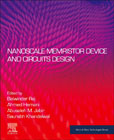
Nanoscale Memristor Device and Circuits Design
Raj, Balwinder
Hemani, Ahmed
Jabir, Abusaleh M.
Khandelwal, Saurabh
Nanoscale Memristor Device and Circuits Design provides theoretical frameworks, including (i) the background of memristors, (ii) physics of memristor and their modeling, (iii) menristive device applications, and (iv) circuit design for security and authentication. The book focuses on a broad aspect of realization of these applications as low cost and reliable devices. This is an important reference that will help materials scientists and engineers understand the production and applications of nanoscale memrister devices. A memristor is a two-terminal memory nanoscale device that stores information in terms of high/low resistance. It can retain information even when the power source is removed, i.e., non-volatile. In contrast to MOS Transistors (MOST), which are the building blocks of all modern mobile and computing devices, memristors are relatively immune to radiation, as well as parasitic effects, such as capacitance, and can be much more reliable. This is extremely attractive for critical safety applications, such as nuclear and aerospace, where radiation can cause failure in MOST-based systems. Outlines the major principles of circuit design for nanoelectronic applications Explores major applications, including memristor-based memories, sensors, solar cells, or memristor-based hardware and software security applications Assesses the major challenges to manufacturing nanoscale memristor devices at an industrial scale INDICE: 1. Introduction: Physics of Memristors2. Historical Background (Comp. Study of Mem with MOSFET)3. Nanoscale Memristor Modeling4. Memristor-based Nanoelectronic Circuits5. Memristives for Nanosensors 6. Memristor-based On-Chip Memory and Storage7. Memristor-based Biologically Inspired Computing (Neuromorphic)8. Memristive Nanoscale Solar Cells9. OxRAM - New Memories for Efficient Computing10. Memristor-based Hardware/software security applications 11. Conclusions and Future Directions
- ISBN: 978-0-323-90793-4
- Editorial: Elsevier
- Encuadernacion: Rústica
- Páginas: 300
- Fecha Publicación: 01/03/2023
- Nº Volúmenes: 1
- Idioma: Inglés
